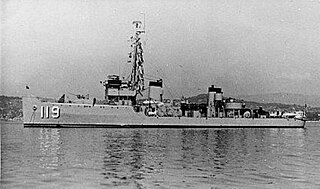
USS Hogan (DD-178/DMS-6) was a Wickes-class destroyer in the United States Navy during World War II.

USS Starling (AM-64) was an Auk-class minesweeper acquired by the United States Navy for the dangerous task of removing mines from minefields laid in the water to prevent ships from passing.

USS Swallow (AM-65) was an Auk-class minesweeper built for the United States Navy during World War II. The ship was the second U.S. Navy ship named after the swallow. Swallow earned two battle stars for World War II service. She was sunk by a kamikaze aircraft off Okinawa on 22 April 1945. She was struck from the Naval Vessel Register on 2 June 1945.

USS Herald (AM-101) was an Auk-class minesweeper acquired by the United States Navy for the dangerous task of removing mines from minefields laid in the water to prevent ships from passing.

The third USS Champion (BAM-1/AM-314/MSF-314) was an Auk-class minesweeper of the United States Navy.

USS Steady (AM-118) was an Auk-class minesweeper acquired by the United States Navy for the dangerous task of removing mines from minefields laid in the water to prevent ships from passing.

USS Sustain (AM-119) was an Auk-class minesweeper acquired by the United States Navy for the dangerous task of removing mines from minefields laid in the water to prevent ships from passing.
USS Annoy (AM-84) was an Adroit-class minesweeper of the United States Navy. She was laid down on 3 December 1941 at Portland, Oregon, by the Commercial Iron Works; launched on 6 April 1942; and commissioned on 2 September 1942, with Lt. John A. Parrish in command. In 1944 she was reclassified as a patrol craft and renamed PC-1588.
USS Superior (AM-311) was a steel-hulled Admirable-class minesweeper built for the U.S. Navy in 1944. Superior participated in the final struggle in the Pacific Ocean against the Empire of Japan during the end of World War II and remained behind, after the war ended, to clear minefields laid during the war.
USS Scurry (AM-304) was a steel-hulled Admirable-class minesweeper constructed for the U.S. Navy during World War II. She was crewed by sailors who were trained in minesweeping, and quickly sent to the Pacific Ocean to clear minefields so that Allied forces could invade Japanese-held beaches. For this dangerous work, often under enemy fire, she was awarded four battle stars.
USS Design (AM-219) was a steel-hulled Admirable class minesweeper built for the U.S. Navy during World War II. A crew, trained in minesweeping, boarded the new vessel, and proceeded to the Pacific Ocean to clear minefields so that Allied forces could safely invade Japanese-held beaches. For this dangerous work under combat conditions she was awarded three battle stars.

USS Rinehart (DE-196) was a Cannon-class destroyer escort built for the United States Navy during World War II. She served in the Atlantic Ocean and Pacific Ocean and provided escort service against submarine and air attack for Navy vessels and convoys. The ship entered the reserves after the end of the war, and in 1950 was transferred to the Royal Netherlands Navy, where she served under the name De Bitter until 1967. She was sold for scrap in 1968.
USS Change (AM-159) was an Admirable-class minesweeper built for the U.S. Navy during World War II. She was built to clear minefields in offshore waters, and served the Navy in the Pacific Ocean.
USS Climax (AM-161) was an Admirable-class minesweeper built for the U.S. Navy during World War II. She was built to clear minefields in offshore waters, and served the Navy in the Pacific Ocean.
USS Compel (AM-162) was an Admirable-class minesweeper built for the U.S. Navy during World War II. She was built to clear minefields in offshore waters, and served the Navy in the Pacific Ocean. Compel was awarded one battle star for World War II service.
USS Concise (AM-163) was an Admirable-class minesweeper built for the U.S. Navy during World War II. She was built to clear minefields in offshore waters, and served the Navy in the Pacific Ocean.
USS Control (AM-164) was an Admirable-class minesweeper built for the U.S. Navy during World War II. She was built to clear minefields in offshore waters, and served the Navy in the Pacific Ocean.
USS Counsel (AM-165) was an Admirable-class minesweeper built for the U.S. Navy during World War II. She was built to clear minefields in offshore waters, and served the Navy in the Pacific Ocean.
USS Implicit (AM-246) was an Admirable-class minesweeper built for the U.S. Navy during World War II. She was built to clear minefields in offshore waters, and served the Navy in the North Atlantic Ocean and then in the Pacific Ocean. She finished the war with two battle stars to her credit.

USS Quest (AM-281) was an Admirable-class minesweeper built for the United States Navy during World War II. She was decommissioned in 1947 after wartime service and transferred to the Philippine Navy in 1948 where she served as presidential yacht RPS Pag-asa (APO-21). In 1955, she was renamed Santa Maria and, later, Mount Samat (TK-21), serving as a patrol corvette of the Miguel Malvar class. She was decommissioned from the Philippine Navy in 1970; beyond that, her fate is not reported in secondary sources.








